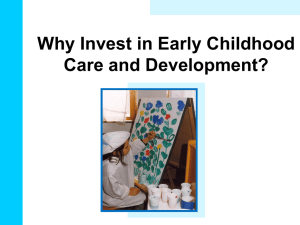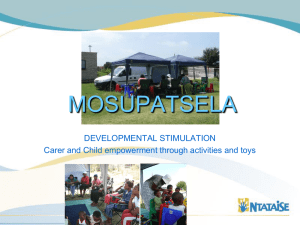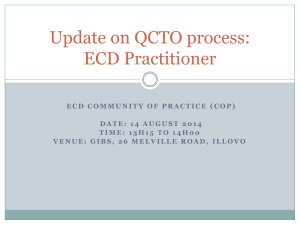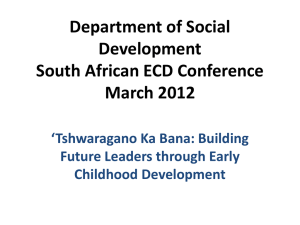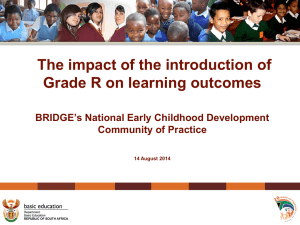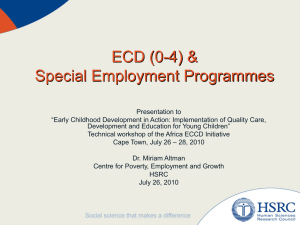Regional trends in ECDE from 2010-2013
advertisement
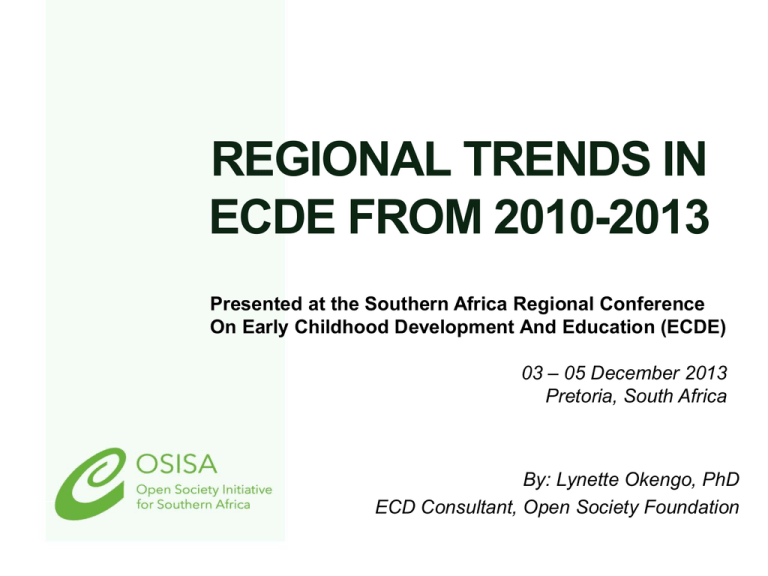
REGIONAL TRENDS IN ECDE FROM 2010-2013 Presented at the Southern Africa Regional Conference On Early Childhood Development And Education (ECDE) 03 – 05 December 2013 Pretoria, South Africa By: Lynette Okengo, PhD ECD Consultant, Open Society Foundation Situation in 2010 Advocacy at various levels Policy development Establishment of ECD programs mostly community based (low access) 2-3 weeks capacity building programmes + ECDVU Concern about lack of programmes for under 3’s General lack of government involvement Programming within the context of high levels of poverty, low resources, limited capacity but growing awareness of importance of early years Context of Children in Southern Africa Trend GDP per capita average annual growth rate Proportion of population living below the poverty line Average annual rate of inflation Gender inequity (Gender equity index) Adult literacy rate: Females as a % of males Food insecurity % of under-fives suffering from underweight % of under-fives suffering from stunting Maternal mortality ratio Access to early learning services Is the situation of children really improving? Improvements are minimal Persistent low child outcomes Negative effects of other factors: Low maternal education Maternal depression relatively common (Africa- 15% - 28%) High exposure to violence (35% of women experience intimate partner or nonpartner violence- WHO 2013 ) Increasing environmental toxins Trends in ECD Program Design Increased discussion on integrated programming: Growing consensus on components of an integrated program Not necessarily one stop shop Growing realization of the importance of a referral system Implementation of pilot programs (sustainable?) Still remains the need for consensus on the implementation of an integrated ECD program Trends in Access Increasing ECD modes of service provision Relatively lower rate for: Children from low income families Children living in marginalized communities Children with special needs Children of mothers with lower education Need to enhance equitable access to Trends in ECD Service Provision Service provision continues to be sector specific Increasing attention to the pre-primary class (R class) Programming for under 3’s increasingly being viewed as a responsibility of the health sector Ongoing limited mainstreaming of ECD into health initiatives Increasing attention to strengthening social Trends in Enhancing Quality More countries developing ECD curricula and training materials More countries developing institutionalized training programs More countries developing ELDS, minimum standards and guidelines Some attention to proposing model classrooms/programmes Increased advocacy for governments to pay ECD teachers/caregivers More needs to be done to support: Establishment of PE programmes Professional development of teachers Assessment Multi-age teaching Reflective teaching Child centered pedagogy Establish support systems for teachers incl. mentors, supervisors Availability of play and early learning materials Continuous quality improvement Capacity building of school administrators, management teams, ECD program officers etc. Trends in Governance of National Programs Governments more responsive to supporting ECD programmes Focus shifting from policy development to implementation. ECD legislation ?? Increased MOE involvement Preprimary increasingly being included as part of basic education, GPE, national plans and budgets Governments focusing more on providing enabling environment esp. for under 3’s rather than service provision Stakeholder accountabilities?? Evidence Generation and Dissemination Increased awareness of importance of building an evidence base Growing realization of the need to integrate learning in M&E models Increased use of participatory research methodology Slow increase of impact evaluations Need for strengthened capacity in designing Trends in Financing of ECD More governments promoting PPP Private entrepreneurs continue to play a critical role in service provision for under 3’s Increasing role of development partners in service provision External funding continues to provide major support to ECD programming Trends in Strengthening Partnerships Parents continue to be recognized as critical partners Emergence of national ECD networks Ongoing discussions for the establishment of regional ECD networks Some evidence of development partner networks Governments encouraging PPP Need to explore more sustainable options of financing ECD Challenges of ECD Programming in the Region Growing but insufficient government commitment and political will Low national prioritization (Inadequate integration of ECD into National Planning Instruments Inadequate resources (financial & human) Mostly donor funded and often unsustainable Largely sectoral with weak co-ordinating structures. Limited access with large regional and national disparities Inequitable access to existing services Low quality of programs Recommendations Continue with advocacy at all levels but with few clear messages targeted e.g. at inclusion of ECD teachers/caregivers into national payroll, institutionalization and accreditation of ECD training as well as increased resource allocation. Continue professional capacity development of ECD practitioners and enhance teacher support systems Strengthen partnership with families and communities Some things never change….. Children who start behind, stay behind…. Cumulative Vocabulary (Words) 1200 Higher income 600 Middle income Lower income 200 16 mos. 24 mos. 36 mos. Child’s Age (Months) Source: Hart & Risley (1995) Thank you for your attention

